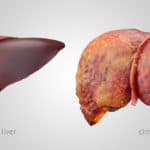HCV Genotype 1 High Dose Therapy Achieves 90% Cure Rate
The following article from HivandHepatitis.com is quite encouraging for genotype 1 patients who believe they must eradicate the virus at any cost. The article is reporting on a study report appearing in the latest issue of the medical journal, Hepatology.
Apparently, two years of high dose, severe side effect, combination therapy actually “cures” the disease in these patients. These are the best results ever reported for genotype 1.
It is especially impressive in light of the fact that the rate for current combination therapy (at lower doses) is just 40% for genotype 1.
Dr. Baker is clearly excited at the prospect of this high a postive response, but is clear in pointing out that it appears to come at a very high cost (considering the severe side effects).
Nine of 10 Chronic Hepatitis C Patients Achieve a Cure 24 Weeks Post-treatment with High Dose Ribavirin Plus Standard Dose Peginterferon Alfa-2a (Pegasys)
By Ronald Baker, PhD
Ninety percent of genotype 1 patients with a high viral load enrolled in a pilot study in Sweden achieved undetectable HCV RNA 24 weeks post-treatment with a regimen of high dose ribavirin plus standard dose peginterferon alfa-2a (Pegasys). By standard definitions, this means they were cured. Results of the small pilot study appear in the current issue of Hepatology (February 2005).
Following are selected highlights of the study and the 72-week findings:
- 7 men, 3 women, with mean age of 51 participated (no African Americans, no cirrhotics);
- All 10 participants were genotype 1, high viral load;
- Patients coinfected with HIV or other diseases were excluded;
- After dose adjustments, mean daily ribavirin dose was 2,540 mg/day (1,600-4,000) at week 2 (the recommended ribavirin dose is rarely above 1,200 mg/day);
- Pegasys (peginterferon alfa-2a) dosing was standard: 180 microgram weekly;
- Side effects were severe, particularly anemia and hemolysis; all patients required erythropoietin, and two patients required 2 separate blood transfusions;
- Treatment duration was 48 weeks;
At the 24-week post-treatment follow-up, 9 of 10 patients had undetectable HCV RNA.
Background
Ribavirin is an antiviral drug that is approved in the US and Europe for use in combination with interferon alfa for the treatment of chronic hepatitis C. The current standard of care in both the US and Europe is combination treatment with peginterferon alfa-2a (Pegasys) or 2b (Peg-Intron) plus ribavirin.
Although the mechanism of action of ribavirn with interferon is not yet completely understood, it is believed to act in synergy with interferon to contribute to significantly increasing (perhaps doubling) the sustained viral response (SVR) rate by preventing virological relapse.
While the effectiveness of antiviral therapy for chronic hepatitis C has improved, individuals with HCV genotype 1, especially those with a high viral load, still do not generally experience an SVR. The SVR rate for these individuals using the current standard of care (peginterferon alfa plus ribavirin) is about 40%.
Ribavirin Dosing
One of the most controversial issues in the management of chronic hepatitis C is the question of what is the optimal dose of ribavirin and whether higher doses of ribavirin produce more effective results than standard doses?
The current recommendation for HCV genotype 1 patients is combination treatment with once weekly peginterferon alfa plus two daily doses of ribavirin for 48 weeks. The current recommended daily dose of ribavirn depends on which brand of interferon alfa is used. In the US, in combination with Pegasys, the FDA-approved dose for ribavirin is 1,000 or 2,000 mg daily, when total body weight is less than 75 kilograms or more than 75 kilograms, respectively; when used with Peg-Intron, the FDA-approved daily dose for ribavirin is a fixed dose of 800 mg. To confuse things even further, the approved daily ribavirin dose in Europe is weight-based, with 800 mg recommended for individuals weighing less than 65 kilograms, 1000 mg for individuals weighing 65-85 kilograms, and 1200 mg for those weighing more than 85 kilograms.
The Swedish Pilot Study
In the current pilot study, the objective was to evaluate the standard dose of peginterferon alfa-2a plus a daily dose of ribavirin that was individualized and calculated from a pharmacokinetic formula based mainly on renal function. In order to reach the targeted concentration of ribavirin in the blood serum, the study participants needed a mean ribavirin dose of 2,540 mg/day (range (1,600-4,000 mg/day). This equals more than double the currently recommended daily ribavirin dose.
Inclusion/Exclusion Criteria
The inclusion criteria for the pilot study were: age >18 years, elevated alanine aminotransferase, positive anti-HCV antibody test, detectable serum HCV RNA, and a liver biopsy consistent with chronic HCV but without cirrhosis.
Patients with other forms of liver disease, active hepatitis A or hepatitis B infection, hepatocellular carcinoma, human immunodeficiency virus infection, anemia, a previous diagnosis of severe depression or other psychiatric disease, significant cardiac disease, renal disease, seizure disorders, severe retinopathy, or pregnancy were excluded from the study.
Adverse Effects
The main side effect was anemia, which was controlled with erythropoietin. Two patients required blood transfusions. However, only minor treatment interruptions occurred among the ten patients who were treated with doses of ribavirin substantially exceeding standard doses. One patient was withdrawn at week 24 because of a lack of viral response, and one patient at week 39 because of side effects, primarily interferon associated.
Conclusions
At follow-up (24 weeks post treatment), nine of ten patients had undetectable HCV RNA. The primary goal of this small pilot study was to determine feasibility and safety of the treatment, and not virological outcome. However, in this difficult-to-treat patient population with genotype 1 and a high viral load, nine of ten patients were cured by standard definitions, which seems to be a better response than that found in studies using standard ribavirin doses.
The authors conclude, “A high dose of ribavirin according to an individualized schedule is feasible but associated with more frequent and serious side effects such as anemia. The viral response merits further evaluation.”
Although the promising results of this small pilot study were striking, and seem to open up a new direction in experimentation with ribavirin dosing and its relationship to improved SVR rates, it’s hard to ignore the potentially deleterious safety issues that might be encountered by many patients using such high ribavirin doses.
As well, cost issues must be considered, not just for the peginterferon and for the high ribavirin dosing, but also for the erythropoietin and possibly blood transfusions. Still, a 90% SVR for genotype 1 patients with high viral loads! It’s a thrilling thought to contemplate!
02/11/05
Departments of Infectious Diseases, Karolinska University Hospital Huddinge, Karolinska Institute, Stockholm, Sweden; Clinical Pharmacology, Karolinska University Hospital Huddinge, Karolinska Institute, Stockholm, Sweden; Renal Medicine, Karolinska University Hospital Huddinge, Karolinska Institute, Stockholm, Sweden.
Reference
K Lindahl, L Stahle, A Bruchfeld and R Schvarcz. High-dose ribavirin in combination with standard dose peginterferon for treatment of patients with chronic hepatitis C. Hepatology 41(2): 275-279. February 2005.







